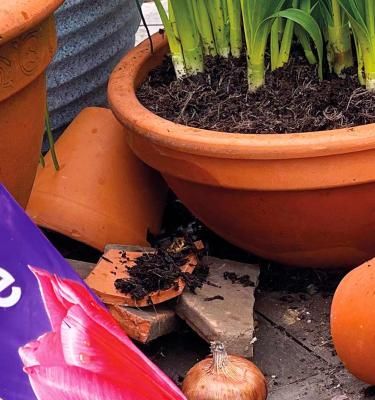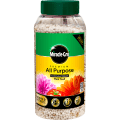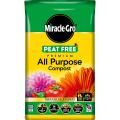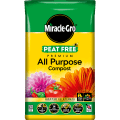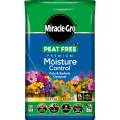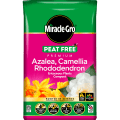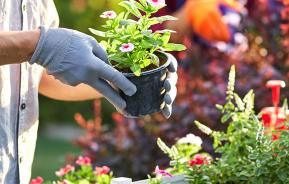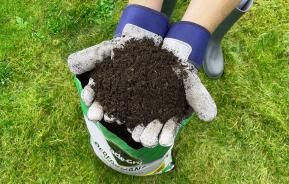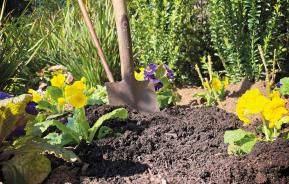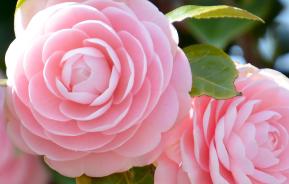The look and feel of Peat Free Compost
Some gardeners are concerned by the slightly ‘bitty’ texture of peat free compost. By taking the peat out of bagged compost, different ingredients have been added, which means that there will be a different look and feel to the compost that some people may have been used to. Many of these ingredients are more fibrous than peat and it can be common to find small pieces of bark and woodchip in the bags. These are nothing to worry about as they all have a job to do including helping with drainage and allowing air to flow through the roots.
- Don't remove any of these bits as they are an essential part of the recipe.
- It's not recommended to sow small seeds in multi purpose peat free compost, it's always best to use a specialist peat free seed and cutting compost such as Levington Peat Free Seed and Cutting Compost.
- When you first open a bag of compost it's good idea to give it a bit of a mix with a small hand fork as this will help it all blend together, especially if it's been lying on a pallet for a while.
Peat free composts can be made from materials such as bracken, sheep’s wool, coir and wood fibre. This may mean that the colour of the compost might be lighter than expected and may not have the earthy smell that gardeners have been used to.
Good quality peat free composts such as Miracle-Gro use carefully blended ingredients that still produce that dark rich colour that most gardeners prefer.
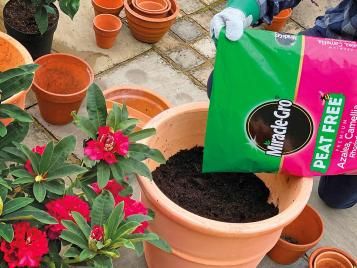
How to use Peat Free Compost
Compost is the foundation for creating a beautiful garden and healthy plants. Whether you are new to gardening or experienced it's always good to make sure you know the best ways to work with your bagged compost.
- Don’t go for the cheapest brand. Peat free compost needs a mix of different ingredients to work well and the cheaper ones are unlikely to have good quality ingredients in them so plant performance is likely to be poor.
- If you're buying compost for house plants or for seed sowing then bring your bags inside to warm up. For outdoor compost try to leave it in a dry place if you’re not going to use it straight away. All bagged composts have small holes in so if left outside for too long they can get wet.
- Try to use the compost within a year as many composts contain nutrients that will be used up within a year when left in the bag.
- For planting in containers and pots, empty the bag of peat free compost into a bucket or trug and give it a good mix with a hand fork before planting.
- Always use fresh compost in containers each year and make sure you have a layer of materials in the bottom of the container to help with drainage before putting in the plant and compost. You can use broken pots or even upturned small plastic plant pots for this.
- Always check that you are using the right compost for the right plant. If you have a plant that says it prefers to be planted in an acidic soil such as a rhododendron then you will need to make sure you use an ericaceous compost such as Miracle-Gro Premium Peat Free ericaceous compost.
- Once you've planted make sure you have firmed the compost gently around the plants roots so that there are no gaps for frost or water to lie stagnant.
- It's important to make sure that you don't overfill the pot with compost, always try and plant the stem to the same height it was in its original pot so make sure you leave enough room at the top for watering without the compost coming over the top.
Plant care
Plants in pots are completely reliant on you for all their needs. This includes watering, feeding, checking for pests and disease as well as making sure they in the right position whether that's shady or sunny. It's a really good idea to get to know your plants and their needs and don't think that once they're planted that all you need to do is a weekly water.
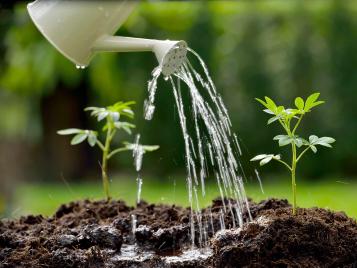
Watering plants in Peat Free Compost
Try not to have a watering regime where you only ever water on a Wednesday whatever the weather. It’s more important that you get to know your plants and follow the advice below.
- Some peat free composts might need a bit more watering than you think due to all the different ingredients. This doesn't mean it's a bad thing, what it does mean is that you do need to keep an eye on your plants regularly.
- After planting, always water thoroughly. Not only is this for the moisture that the plant needs but watering also helps to settle the roots and you will know if you need to add any more compost to the pot if it sinks after watering.
- Once you've done that first watering and the water has drained away, give the pots a lift if you can as this will help you get to know how the plant and pot feel when they have the right level of water.
- Due to the woody materials of peat free composts, it may seem the pot is very dry as sometimes the top can look dry. Before you reach for the watering can carefully stick your finger into the compost and give her a wiggle. When you pull your finger out if your finger is dry and clean that will mean but your plant needs watering as it's dried out, if on the other hand your finger comes out dirty with compost and damp the plant won't need watering just yet.
- Another way of checking is to lift the pot up. If the pot is really heavy as it was after the very first watering you gave it, that most likely means it won't need any more. If the pot is very light when you pick it up, then you most probably need to water.
- As compost dries it starts to shrink so look at the edges of the pot and if the compost is coming away from the edges that will mean it needs watering.
- You can also tell if your plant is looking thirsty by its leaves starting to wilt. Try not to let the plant get to that stage as frequent drying out will put a plant under stress and it will never be as healthy as a regularly watered one.
- The best time to water is in the morning or late afternoon /early evening. When watering, try and give your plants a proper soak rather than a little dribble, this means the water will really get to where it's needed, at the roots.
- If when watering you notice that the water is pouring out of the bottom it usually means the plant is very dry and what you can do is pop the pot in a bucket and half fill it with water, leave the pot to soak up the water for about 30 minutes to properly rehydrate the plant. Peat free compost is much better at rehydrating itself then peat based ones.
Feeding plants in Peat Free Compost
Many gardeners don't realise that feeding their plants, especially those in containers is just as important as watering properly. In order to get the best out of your plants they need three main nutrients, nitrogen for good leafy growth, phosphorus for strong root growth and potassium for excellent flowering and fruiting. These will often be labelled on a plant food bottle as NPK with numbers next to them.
These numbers are nothing to be scared of, they are what your plants need. A quality brand of peat free compost will contain these nutrients with some lasting for three months but others only six weeks.
Even though many composts already contain the right nutrients, it has been found that there are some plants that use up the nutrients more quickly when planted in peat free. This means that you might need to start supplementary feeding your plants a little bit earlier.
